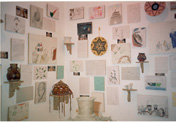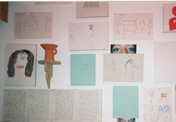| |
 |
Artist on a Mission
by Loolwa Khazzoom
“The art world likes to see itself as avant-guard, the most open-minded
enclave of society,” remarks Israeli art critic Ktzia Alon. “But
Shula Keshet has put a mirror in front of those who share this
view. They have discovered that they are a closed, elitist, hermetic
group.” Keshet is a revolutionary, according to Alon, and it is
just a matter of time before key museums and art magazines throughout
Israel follow her lead.
“I am not the kind of artist who
sits in a studio, disconnected from the
world, thinking that what I am doing
is more important than what is
happening in society,” Keshet says of
herself. “On the contrary, the core of
my artwork is my connection with
people and their struggles for justice.”
This sense of connection has led
Keshet to launch an ongoing series of
exhibitions, where her own installation art fuses with the work of
individuals from Mizrahi (Middle
Eastern/North African Jewish),
Ethiopian, and Arab communities in
Israel. “I want to break the standard
relationship between artist and
subject, where the artist is the one
looking and the one producing art. My
art bears the imprint of many different
people, all speaking for themselves.”
Keshet
challenges the Israeli idea of art itself: “There is a separation
between ‘high’ art and ‘low’ art,” she asserts. “So-called ‘high’
art is Western-influenced. Mizrahi, Ethiopian, and Arab art is
not perceived as ‘high’ or ‘true’ art, but rather as handicraft.
It is my goal to elevate people’s conceptualization of these art
forms, to bring other narratives into the Israeli art world.”
Shlomo
Akale, director of Bahalachin Center for Ethiopian Culture, welcomes
such a change. “There is a lot of hierarchy in the Israeli art
world,” he concurs. He explains that common measures of artistic
worth - such as graduation from a prestigious art academy - are
irrelevant in an Ethiopian context. “In Ethiopia, everyone did
something connected to art - weaving, pottery, carpentry, embroidery.
We didn’t have schools for art. Art was life. In Europe, people
had to go to schools, study for a period of several years, and
receive certificates. In Ethiopia, however, boys learned art from
their fathers, and girls learned art from their mothers.”
Keeping
to the mother-daughter artistic tradition, Mira Tezasu and Tasamach
Mengestu both displayed their artwork as part of Keshet’s installation
on Ethiopian art, Halom Yerushalmi Mehabash, at the Einstein Contemporary
Art Gallery in Tel Aviv in 1998. Tezasu displayed poetry and paintings.
Her mother, Mengestu, displayed pottery. “Ethiopian art such as
baskets, pottery, and embroidery serve people in their everyday
lives,” Keshet says. “I was making a statement by including daily
art alongside the paintings and drawings, because art should not
just be something you look at. It should be something you use.
It should not just be something the elite sell, without touching
it.”
Tezasu
feels Keshet was successful in making her statement. “The exhibition
helped show that art like my mother’s is real art. Finally people
valued her work and recognized how beautiful it is. Suddenly my
mother had exposure and began receiving invitations to display
and discuss her art.” Tezasu explains how her mother gained prestige
that elders of the Ethiopian Jewish community lost after arriving
in Israel. “The exhibition really empowered my mother,” she explains.
“Elders in the Ethiopian community are often ignored here. But
through this exhibition, my mother got the honor she deserves.”
Tova
Mered, director of the Ethiopian Art Center, elaborates on the
phenomenon of losing status: “Every Ethiopian child in kindergarten
thinks she is wiser and more important than her parents and grandparents,
because she knows how to write her name in Hebrew.” Mered works
to turn the tables by providing a center where elder women of
the community teach Ethiopian art to Israelis of all backgrounds
and ages.
Ilana
Shamai, program director of Inbal - a center for Mizrahi cultural
advancement - looks forward to the day that this expression will
be standard. For now, she asserts, “Mizrahi artists who do not
completely erase their Mizrahi identity are automatically cast
aside on the peripheries of the art world.”
Keshet, however, demands the
room to express herself as a Mizrahi
while receiving full-blown recognition
in the mainstream. Indeed, she seems
to be getting her way. Her exhibitions
have been well-attended and reviewed
in key Israeli periodicals including
Ha’aretz, Studio, HaIr, Yediot
Ahronot, and Ma’ariv.
Keshet’s
next installation will focus on the theme of common identity between
Jews, Muslims, and Christians throughout the Middle East and North
Africa. “This installation will emphasize the connection between
Mizrahim and Arabs, Mizrahim and Palestinians,” she says. The
theme of a Mizrahi-Arab connection is nothing new for Keshet,
who created a series of self-portraits fusing images of herself
and Islamic art.
Keshet’s self-identification and
forthcoming exhibition may be
shocking to some. Then again, Shula
Keshet does not pull punches. She is
an artist on a mission.
Loolwa
Khazzoom has published widely in such periodicals as The Washington
Post, Rolling Stone, Marie Claire, Yoga Journal, and Elle Girl.
She is the editor of The Flying Camel: Essays on Identity by
Women of North African and Middle Eastern Jewish Heritage (Seal
Press), and she is an Israel correspondent for Jewish Telegraphic
Agency. More about the author at: (http://www.loolwa.com/ articles.html)
|
|

Artwork
by Shula Keshet

|
 |